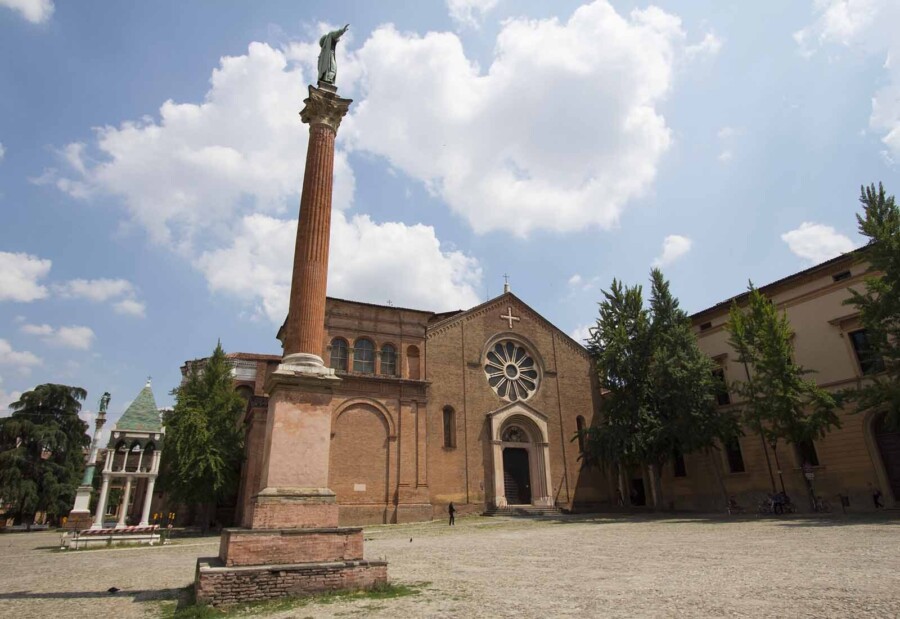Basilica di San Domenico: Michelangelo in Bologna

The Basilica di San Domenico is one of Bologna’s most remarkable religious and artistic landmarks.
Known as the final resting place of Saint Dominic, the basilica is also home to some of Michelangelo’s early masterpieces, making it a must-visit destination for art lovers and history enthusiasts alike.
Explore the history, artistic treasures, and Michelangelo’s contributions that make this basilica an essential stop when visiting Bologna.
History of the San Domenico Basilica
Founding and early history
The history of the Basilica of San Domenico begins in 1218.
That year, Domenico di Guzmàn, founder of the Dominican order, arrived in Bologna after fighting the Cathar heresy in Languedoc.
Upon his death in 1221, the friars began building the basilica and the convent, starting from the pre-existing church and the large nearby lands.
The façade shows the original Romanesque church, with the large rose window from the 13th century, and the exterior of the Renaissance Ghisilardi chapel.
Architectural development
Over the centuries, the church evolved, blending architectural styles from different periods, including Romanesque, Gothic, and Baroque.
Key expansions included the construction of the grand facade, the chapels, and the magnificent Ark of Saint Dominic, where Saint Dominic’s remains are enshrined.
These additions transformed the basilica into a spiritual and artistic treasure trove.

Michelangelo’s masterpieces
One of the basilica's most famous features is the Ark of Saint Dominic (Arca di San Domenico), a beautifully sculpted marble tomb created by several renowned artists, including a young Michelangelo Buonarroti.
The Ark of Saint Dominic
The Ark of Saint Dominic is a large marble structure housing the saint’s relics.
It was designed by Nicola Pisano and later enriched by other master sculptors: Niccolò dell'Arca, the author of the Compianto of Santa Maria della Vita, Michelangelo Buonarroti, Alfonso Lombardi and Jean-Baptiste Boudard.
When Michelangelo arrived in Bologna as a young artist, he was commissioned to complete three statues on the ark, showcasing his early artistic mastery.
Michelangelo’s Sculptures on the Ark
- Statue of Saint Petronius
Saint Petronius, the patron saint of Bologna, is depicted holding a model of the city in his left hand and a bishop's staff in his right.
Michelangelo’s attention to detail, especially in the drapery and facial features, reflects his mastery of classical sculpture.
The pose of the legs suggests a character in the act of moving forward in a solemn and composed manner. - Statue of an Angel Holding a Candelabrum
The angel has powerful forms and seems inscribed within a cubic scheme. He holds an elaborately carved candelabrum with an expression of internal energy. - Statue of Saint Proculus
Saint Proculus is shown as a muscular, heroic figure holding a sword, ready for action.
The statue’s power and tension highlight Michelangelo’s growing fascination with human anatomy and movement, traits that would define his later works. The hand gesture of Saint Proculus recalls that of David in Florence.

Other artistic and architectural highlights of the San Domenico Basilica
The Basilica di San Domenico is not only about Michelangelo’s sculptures.
It is also a treasure trove of religious art, stunning frescoes, and architectural wonders.
1. Interior design and chapels
The basilica’s interior is a harmonious blend of Gothic and Baroque styles. The main altar and choir are richly decorated with religious symbols, while numerous chapels showcase impressive works of art.
2. Frescoes and paintings
The basilica contains masterpieces by famous Italian painters such as:
- Guido Reni: Known for his dramatic religious works. Inside the chapel of the rosary, you can find his grave. He decorated the walls of chapel with the Saint Dominic's ark.
- Filippino Lippi: His paintings add a Renaissance touch to the church’s walls. Look for his mystical marriage of Saint Catherine of Alexandria.
- Ludovico Carracci: His works highlight Bologna’s artistic legacy during the Baroque period. You can find his fresco of Saint Dominic. See more works by Carracci's brothers at Bologna Pinacoteca.
3. The cloisters and monastic complex
Don’t miss the peaceful cloisters, a serene part of the monastic complex where Dominican friars lived and studied.
The elegant arcades and well-kept gardens offer a calm retreat from the bustling city streets.
Practical information for visiting the Basilica
- Location: Piazza San Domenico, 40124 Bologna
- Opening Hours: Typically open from morning to evening, with a break during lunch hours.
- Admission Fees: Entry is usually free, though donations are welcome.
Final tips
The Basilica di San Domenico Bologna is a true cultural and artistic treasure, blending history, faith, and artistic mastery.
Michelangelo’s early works, the breathtaking architecture, and the serene atmosphere make it an unforgettable destination for any visitor to Bologna.
Don’t miss the chance to explore this remarkable site and experience a pivotal chapter in Italy’s rich artistic legacy.
Photo credits: Fr Lawrence Lew, O.P. @Creative Commons


